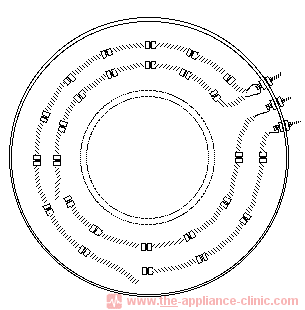Home Page > Troubleshooting and Repair > GE Electric Dryer > Automatic Cycles
Proper Operation
Learn how your appliance is supposed to operate so you can determine if it is malfunctioning.
This page contains affiliate links. For more information visit our
FTC disclosure page.
- Visit our sponsor for parts:

Automatic Dryer Cycles

When electric dryers appeared on the market more than forty years ago, the housewife guessed how many minutes it would take to dry the clothes. This was an inexact science, at best, and twenty years or more later, schemes were invented to sense when the clothes were dry and to shut the dryer off.
One common 'auto' design supplied power to advance the timer only when the heater cycled off. The assumption was that if the clothing was wet the dryer thermostats would keep the dryer heat on. Once the clothing dried sufficiently the thermostat would cycle the heat off more frequently, resulting in the timer running more and eventually getting to the end of the cycle just as the clothing was dry, saving power.

On dual-element GE dryer models (the most common), power to advance the timer is fed through one of the dryer's two heater element coils. If that one element should fail, the dryer might still heat a somewhat but no power would ever get to the timer to allow it to advance to the OFF position. On single-element dryer models, a 'power resister' is used in series with the thermostat which when open allows power to flow to the timer motor. If the dryer is still heating but the timer not advancing on an 'auto' setting, that power resister may be suspect.
Some of the later designs to actually sense moisture in the clothing were very complex. Various sensors were imbedded in the back wall of the dryer drum which in turn came into contact with wet tumbling clothing creating a short in the sensor circuit. As the clothes dried they would make less and less contact between the sensors so the control would let the timer advance to the end of the cycle. As often happens, the complexity of the moisture measurement systems led to reduced reliability and even ruined clothes!
Home Page > Troubleshooting and Repair > GE Electric Dryer > Automatic Cycles > How old is my Appliance?
All of the information in these Appliance Clinic procedures is provided FREE OF CHARGE. No liability is assumed by the author for the accuracy of the contents or damages caused by the use of these procedures.

